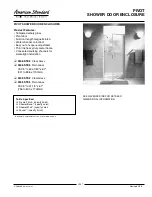
Switches &
Pilot Lights
Display
Lights
Display
Units
LED
Illumination
Units
Safety
Products
Terminal
Blocks
Comm.
Terminals
AS-Interface
Relays &
Timers
Sockets
Circuit
Protectors
Power
Supplies
PLCs &
SmartRelay
Operator
Interfaces
Sensors
Control
Stations
Explosion
Protection
References
Flush
Silhouette
719
HS5E Miniature Interlock Switches with Solenoid
Instructions
Safety Precautions
Install the rear unlocking button kit in the correct direction
as shown below. Do not install the kit in incorrect directions,
otherwise malfunction will be caused.
Correct
I
ncorrect
Do not apply strong force exceeding 100 m/s
2
to the interlock
switch while the rear unlocking button is not pressed, otherwise
malfunction will be caused.
Manual Unlocking using the Rear
Unlocking Button
The rear unlocking button is used by the operator confi ned in
•
a hazardous area for emergent escape.
Unlock
Rear Unlocking Button
Unlock
Rear Unlocking Button
How to operate
When the rear unlocking button is pressed, the interlock
•
switch is unlocked and the door can be opened.
To lock the interlock switch, pull back the button.
•
When the button remains pressed, the interlock switch cannot
•
be locked even if the door is closed, and the main circuit
remains open.
Safety Precautions
Install the rear unlocking button in the place where only
•
the operator inside the hazardous area can use it. Do not
install the button in the place where an operator outside the
hazardous area can use it, otherwise the interlock switch can
be unlocked during usual machine operation, causing danger.
Operate the rear unlocking button by hand only. Do not
•
operate using a tool or with excessive force. Do not apply
force to the button from the direction other than the proper
direction, otherwise the button will be damaged.
Recommended Tightening Torque
HS5E interlock switch: 1.8 to 2.2 N·m (four M4 screws)
•
(Note)
Rear unlocking button: 0.5 to 0.7 N·m
•
Rear unlocking button kit: 4.8 to 5.2 N·m
•
(M5 screw)
Actuators
•
HS9Z-A51:
1.8 to 2.2 N·m (two M4 screws)
HS9Z-A52:
0.8 to 1.2 N·m (two M4 Phillips screws)
HS9Z-A51A/A52A: 1.0 to 1.5 N·m (two M4 screws)
HS9Z-A53:
4.5 to 5.5 N·m (two M6 screws)
HS9Z-A55:
1.0 to 1.5 N·m (two M4 screws)
Note: The above recommended tightening torque of the mounting screws
are the values with hex socket head bolts. When other screws are
used and tightened to a smaller torque, make sure that the screws do
not become loose after mounting.
To avoid unauthorized or unintended removal of the interlock
•
switch and the actuator, it is recommended that the interlock
switch and the actuator are installed in an unremovable
manner, for example using special screws or welding the
screws.
When installing the HS9Z-A51A and HS9Z-A52A actuators,
•
use the washer (supplied with the actuator) on the hinged
door, and mount tightly using two M4 screws.
Mounting centers:
12 mm (factory setting), adjustable to 20 mm
M4 Screw Hole
Hinged Door
Note:
Choose mounting centers of either 12 mm or 20 mm.
M4 Screw
Rubber Bushing
Washer
Cables
Do not fasten or loosen the gland at the bottom of the safety
•
switch.
When bending the cable during wiring, make sure that the
•
cable radius is kept at 30 mm minimum.
When wiring, make sure that water or oil does not enter the
•
cable.
Do not open the lid of the interlock switch. Otherwise the
•
interlock switch will be damaged.
Gland
Minim
um
Radius
30 mm min.
Lid
(48)
HS5E


































